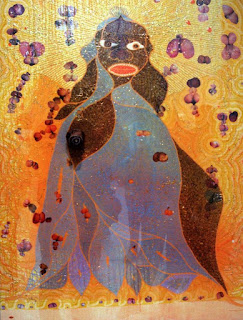The early years of the 20th Century signed a terrific advance in the Physical Sciences. The Special (1905) and General (1916) Theories of Relativity and the advent of Quantum Mechanics (1926) changed our lives profoundly. Around the same years, a similar revolution took place in both Music and Art. The year 1909 marks a decisive break with tonality (the structure of classical music) by Arnold Schönberg in his "Three Piano Pieces". The term 'Atonality' is commonly used to refer to this new type of composition. Wassily Kandinsky is credited with painting the first 'purely abstract' works. His production is vast and I could only include 20 of his works here, selected from a period of time that overlaps with the musical pieces by Schönberg presented in this video. They knew each other and have possibly influenced their works reciprocally. The video is an attempt to evince this intriguing 'connection' between music and painting.
Arnold Schönberg (1874-1951): ...The final piece (of the Three Piano Pieces, Op.11) breaks through all constraints of traditional language or structure, cutting abruptly from extremes of eruptive power, as in the massively congested opening, to the most intense introspection. Perhaps Schoenberg had in mind Kandinsky, with whom he had close contacts, when he likened such music to developments in painting - "without architecture ...an ever-changing, unbroken succession of colors, rhythms and moods." (From a Text by Peter Hill).
Wassily Kandinsky (1866-1944): ...As the "Der Blaue Reiter"(*) Almanac essays and theorizing with composer Arnold Schönberg indicate, Kandinsky also expressed the communion between artist and viewer as being available to both the senses and the mind (Synesthesia). Hearing tones and chords as he painted, Kandinsky theorized that, for instance, yellow is the color of middle C on a brassy trumpet; black is the color of closure, and the end of things; and that combinations of colors produce vibrational frequencies, akin to chords played on a piano. Kandinsky also developed a theory of geometric figures and their relationships, claiming, for example, that the circle is the most peaceful shape and represents the human soul.
Three Piano Pieces, Op.11 (1909)
(
00:00) 01. At a Moderate Speed (Study for Improvisation 8 (1909))
(
05:00) 02. At a Moderate Speed (Two Riders and Reclining Figure (1909-1910) and Improvisation No.20 (1911))
(
14:46) 03. With Motion (Last Judgement (1912))
Six Little Piano Pieces, Op.19 (1911)
(
17:35) 04. Lightly, Gently (Composition VII (1913))
(
19:03) 05. Slowly (Composition VII (1913))
(
19:57) 06. Very Slowly (Composition VII (1913))
(
20:56) 07. Quickly but Light (Composition VII (1913))
(
21:22) 08. Rather Quickly (Composition VII (1913))
(
21:59) 09. Very Slowly (Composition VII (1913))
Five Piano Pieces, Op.23 (1920)
(
23:18) 10. Very Slowly (Improvisation 31 (Sea Battle) (1913))
(
25:35) 11. Very Quickly (Small Pleasures (1913))
(
27:05) 12. Slowly (Painting with Red Spot (1914))
(
30:30) 13. Sweepingly (Moscow I (1916))
(
33:04) 14. Waltz (Overcast (1917))
Suite for Piano, Op.25 (1921-1923)
(
36:39) 15. Praeludium (White Line (1920))
(
37:43) 16. Gavotte (Study for "Circles on Black" (1921))
(
38:53) 17. Musette (White Zig Zag (1922))
(
40:12) 18. Gavotte (On White II (1923))
(
41:26) 19. Intermezzo (Throughgoing Line (1923))
(
45:38) 20. Menuett (Composition VIII (1923))
(
47:41) 21. Trio (Delicate Soul (1925))
(
48:18) 22. Menuett (Delicate Soul (1925))
(
49:52) 23. Gigue (Yelow-Red-Blue (1925))
(
52:30) 24. Piano Piece, Op.33A (1928) (Several Circles (1926))
(
54:53) 25. Piano Piece, Op.33B (1928) (Multicolored Resonance (1928))



